Below is the link to my contribution to Tennis with an Accent —> My recap/analysis of Kevin Anderson’s epic upset of Roger Federer in the quarterfinal round of Wimbledon on Wednesday.
Link: Anderson Ups the Ante
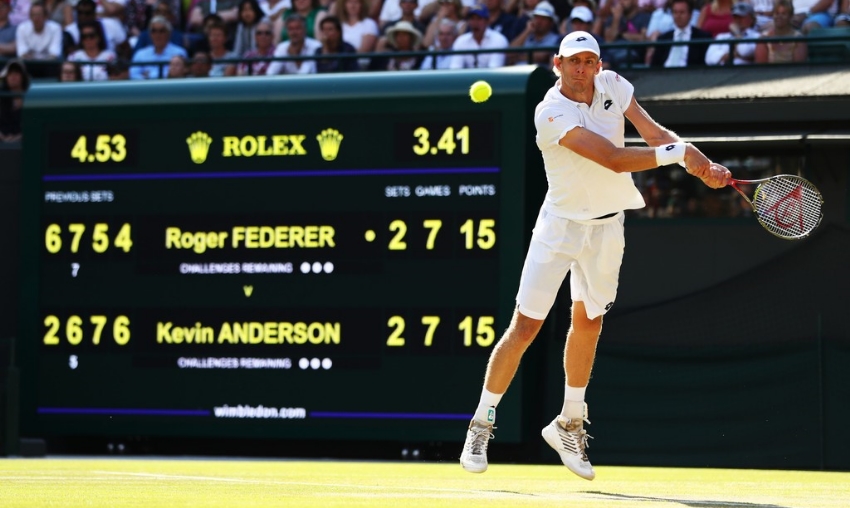
Until next time…
Below is the link to my contribution to Tennis with an Accent —> My recap/analysis of Kevin Anderson’s epic upset of Roger Federer in the quarterfinal round of Wimbledon on Wednesday.
Link: Anderson Ups the Ante

Until next time…
Dominic Thiem def. Kevin Anderson 6-4 6-2
There was little doubt earlier today that this top-10 encounter presented all kinds of match-up problems for the eighth-ranked Anderson, the 2017 US Open finalist. Thiem, a spot ahead of Kevin in the ATP rankings, is the steadier baseline rallier and he was getting to play on his favorite surface, as opposed to his opponent who has yet to win a title on clay courts. And frankly, Thiem’s 0-6 record vs Anderson, none played on clay, mattered little in today’s outcome.
Anderson would naturally have to rely on his serve but what was he to do on the return games? That was a question that haunted him throughout the match, one to which he could not come up with a response against Dominic who was, for his part, oozing with confidence following his upset win over Rafael Nadal one day earlier.
Anderson began the match on his serve and the expected pattern settled in early, too soon for the South African. He found it difficult to push Thiem around. Instead, the Austrian was the one striking the corners with considerable depth making Kevin scramble, a lot.
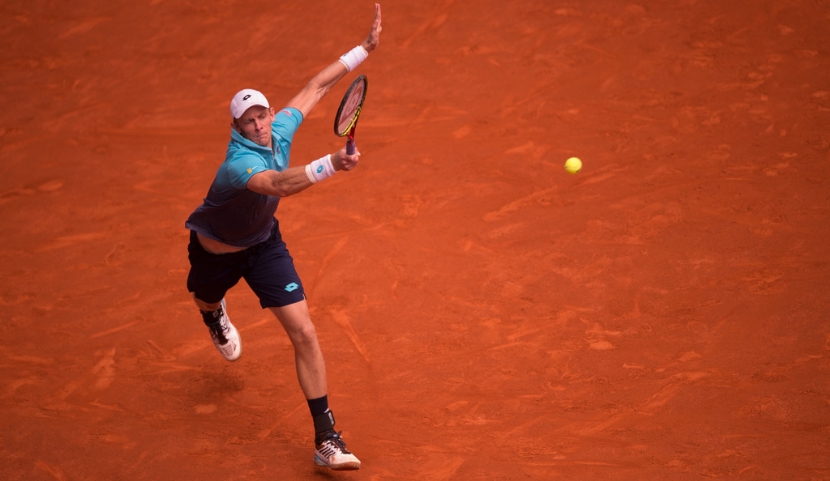
The 30-30 point put on display the type of rally on which Thiem built his impressive clay-court career. It lasted around twenty shots. Anderson not only got stuck three meters behind the baseline, running left and right to retrieve balls, but ended up losing it in the most discouraging way possible, with Thiem stepping inside the baseline on a short ball and smacking the inside-out forehand winner.
Anderson did save the ensuing break point thanks to a big first serve – precisely what he needed – but could not turn this nine-minute-long game in his favor. He won a point or two more on big serves but anytime Dominic got the return in and the rally began, Anderson would force the issue and make the error. His last one in the game came when he sailed a forehand deep on the third break point.
Following a comfortable hold by Thiem, Kevin trailed again (0-30) on his serve. It was clear that he needed to avoid extended baseline rallies at all cost. This is probably why he began going for big cuts on the second shot following the serve, and even served and volleyed once – which, in retrospect, he should have attempted to do more in the set than just this one time. He came back and held serve before the first set got out of control from his perspective. Nevertheless, he was still behind a break, and Thiem’s serve was clicking. He played an Anderson-like game, winning three points directly on well-placed serves, to go up 3-1 and keep the break advantage.
Instead of Anderson challenging Thiem for a break and looking to level the score, he ended up being the one to struggle on his service games. After saving two more break points at 1-3, he succeeded to stay within distance with a big service winner at deuce and a well-timed drop shot in the next one.
Unfortunately for Anderson, Thiem responded with another routine hold to go up 4-2.
Unfortunately for Anderson, this pattern would continue for the rest of the match.
Except the one anomaly at 5-4.
Something extraordinary needed to take place to cause a glitch in that pattern and it took place in that tenth game. Thiem committed a double fault at 0-15, and Kevin fired a flat and hard return – despite a bad bounce on the second serve – that forced Thiem to misfire a backhand. All of a sudden, Anderson had three break-point opportunities at 0-40.
But that is where the anomaly ended.
Kevin missed a forehand deep at 0-40, another one at 15-40, and backhand deep on the third one. “Poof” flew away his only chance to sink his teeth into the match, in a game where Thiem made only one out of eight first serves.
It would not be fair to say though that it was all due to Anderson’s missed shots. Thiem did come up with three terrific second serves in succession – from 15-40 to ad-in – that did not allow Anderson to nail the returns for winners, something he was definitely aiming to do at that point. On set point, Thiem made a first serve, his only one in the game, and completed the 1-2 punch with a forehand cross-court winner.
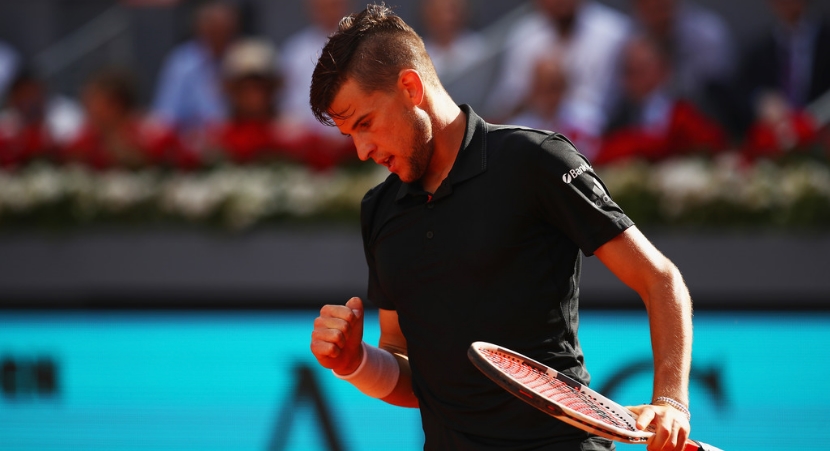
It only got worse from that point forward for Anderson, beginning with a double fault to lose his serve to start the second set. It did not help either that Anderson’s first-serve percentage hovered around 50% in the second set. The pattern that I described above, score-wise and tennis-wise, for the first set continued even more blatantly. No anomalies, no glitches.
Thiem would solidify his lead with another break and oust the South African with a score of 6-4 6-2, in a comprehensively dominating performance. Now he needs to erase the one anomaly for his career. For as accomplished a clay-court player as he is, he has yet to win his first ATP-1000 title on the surface. Alexander Zverev stands in his way tomorrow.
Alexander Zverev def. Denis Shapovalov 6-4 6-1
Alexander “Sascha” Zverev is the third-ranked player in the world, already holding two ATP 1000 titles at the age of 21. Denis Shapovalov, at the age of 19, is one of the most exciting up-and-comers, the youngest top-100 member of the ATP rankings at no.43 (probably top 30 by Monday). Both are former junior champions at Majors (Sascha at the 2014 Australian Open, Denis at the 2016 Wimbledon), and experienced meteoric rises following their junior careers to eventually reach their current rankings.
Both have already recorded wins against the ATP’s elite. Both still have plenty of room for improvement.
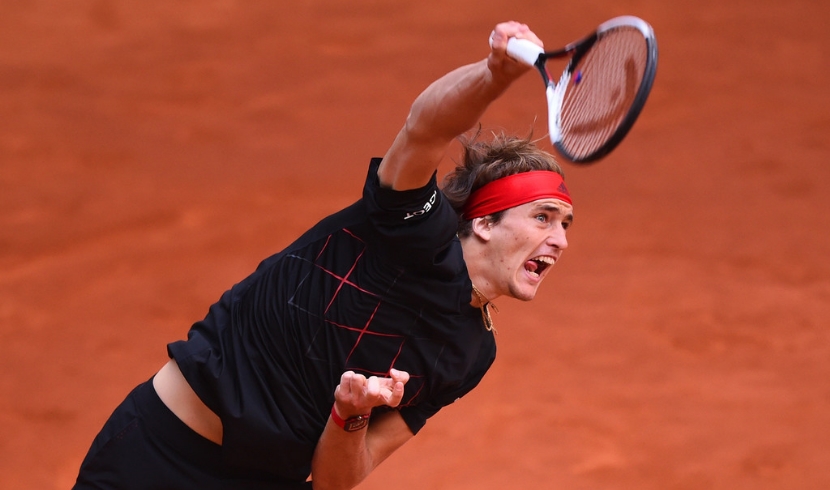
On top of everything else, both play exciting brands of tennis. Zverev relies on a powerful first serve, a fundamentally sound backhand, and the ability to generate power from the baseline. Shapovalov counts on his terrific shot-making skills and overall aggressive play. Both are brave, both are athletic.
For all the above reasons and more, there was no reason why any tennis fan should not have been excited to watch these two names face each other in the semifinals of an ATP 1000 event.
Did it live up to its billing? No, it did not.
Until 4-4, each player comfortably held serve, not because they were hitting extraordinary shots – only a few, combined – but rather because their opponent would either miss the return or make an error in the next shot. The only deuce came at 2-2 on Shapovalov’s serve, but he won the next two points without much difficulty. There were not even many rallies that went beyond five shots during this stretch. The quality barometer remained inoperative because neither returning player pushed the other one to raise his level on service games.
Zverev broke through one of the best shots of the match until then, a well-placed backhand down-the-line return that Denis could not get back in the court. He did nevertheless get to that break point thanks to two unforced errors by Shapovalov, the second one coming on a framer at 30-30. That was all that the German needed as he closed out the set on his serve with a forehand winner on a 1-2 punch.
Prior to the match, we were wondering how Shapovalov would react to his forehand cross-court, one of his favorite weapons, going to Zverev’s strong side, or if Zverev would respond to Shapovalov’s power with counter-strikes or steady retrieval, or if Denis would consider coming to the net to finish some points instead of going for winners with big cuts from the baseline.
Yet, nothing that elaborate took place in the confines of the Manolo Santana Court. Instead, we got a dud first set – dud (adj.): not working or meeting standards; faulty.
It basically consisted of errors, one bland break, and only a handful points worthy of mentioning.
Contrary to the first set, the second started with a break, and marked the moment where one of the players finally elevated his level. Zverev hit two spectacular winners, both followed by pumped-up screams and fist pumps, that helped him get the definitive lead on the Canadian.
Sascha started holding his end of the bargain from that point forward, or at least, showing glimpses of his potential. Denis, for his part, never took off. He fell behind 0-4 in the blink of an eye. It was a constant drip-drip of errors that would not cease, a backhand smacked in the net here, an overhead from the top of the net framed deep there, and so on.
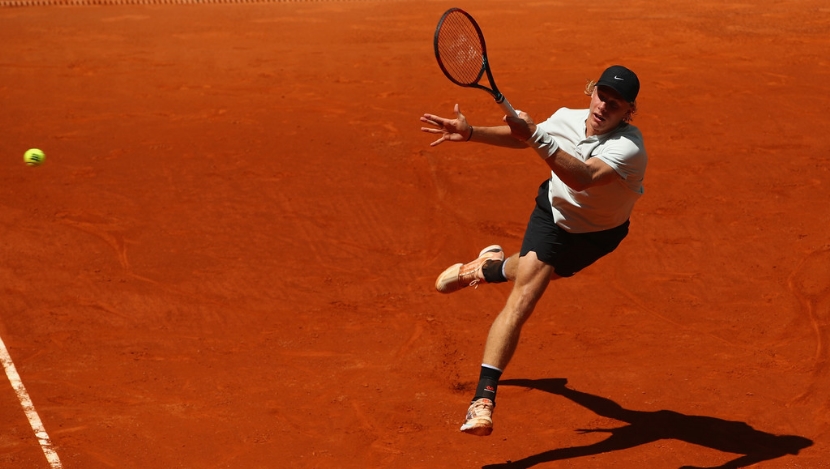
The encounter was over in 58 minutes, with the final score of 6-4 6-1.
Sascha could not have asked for a better outcome in a match that began past 10 PM in Madrid. The last thing he needed was to get involved in a long battle that finishes past midnight and does not allow him enough rest time to properly get ready for tomorrow’s final. He not only avoided that, but also finished on a strong note, never mind that he was largely left unchallenged by his opponent.
As for Shapovalov, his second career semifinal in an ATP 1000 tournament resulted in a straight-set loss again, suffered at the hands of the same player (first one, Canadian Open 2017). This semifinal run on the red clay of Madrid is still a major step forward for the Denis who, I imagine, would have gladly accepted it, had it been offered prior to the tournament’s start.
All eyes now turn to tomorrow’s final, pitting two of the best baseliners in the men’s game. As a fan, I can only hope that it will be more closely contested than today’s semifinals.
Denis Istomin, the 103rd-ranked player from Uzbekistan (highest: 33 in 2012), defeated the 20th-seed Kevin Anderson 4-6 6-7(13) 6-4 7-6(2) 6-3 in the first round of Wimbledon. It was a thrilling come back by a player who has gone through his own trials and tribulations throughout his career. He has had to deal with numerous injuries and was severely injured in a car accident on his way to a junior tournament when he was 14 years old, one that resulted in a broken leg and required 80 stitches and a three-and-a-half-month-long stay in a hospital for recovery.
He is also coached by his mother – considered an “unusual arrangement” in a world dominated by male coaches – who got him back on the court two years after his accident. I thought it would be a good idea to give this background information before showing the interview below, because I did not want Denis to have to talk about these topics again. I am sure he has had to answer hundreds of question about them, although, as you will notice, he seems “pretty cool” about it.
Below is my chat with the soft-spoken, polite 29-year-old Istomin, following his thrilling win vs Anderson. He will face Nicolas Almagro in the second round.
You had 7 set points, yet you lost the 2nd set 15-13 in the tiebreaker to go down two sets to nothing. You were up 6-3 and the first three set points in a row, and the point at 6-4 was the longest rally of the match. Yet, you still managed to come back and win in 5 sets. I am curious, how quickly did you recover mentally after that second-set tiebreaker?
From 6-3 to 6-6 in the tiebreaker, I think he had a good serve. Then, yes, the next point was a Iong rally and I missed the down-the-line backhand a bit long. Then at 6-5, after this kind of point, you know, it’s tough to serve well because you are still tired from the last point. He also hit a good, aggressive return and got back to 6-6. After that, he served unbelievable the rest of the tiebreaker, I had no chances to put the set away although it was a long tiebreaker. When I lost that and went down 2-0 in sets, I took the points one by one, and hoped that I can make a break somewhere. I got lucky but I managed to get a break in the third set. But it changed the game completely. I started to play better, more aggressive, with the momentum. It continued and I played very well in the fourth set tiebreaker. I also think he got tired after the fourth set as well. I could see that and I just waited for my chance to break again.
I thought for a little while that he was getting tired toward the end of the second set, but he played another three sets after that.
Well, it’s a three-out-of-five-set match anyway, but he is good on this surface and he served very, very well. But I had more chances to break later for sure. For example, in the first two sets, I had maybe two or three break points, but then I started to return well and I had more and more chances. Third set, I also changed my tactic a little bit. I began hitting drop shots to make him run a little bit, maybe that had an effect on him as well.
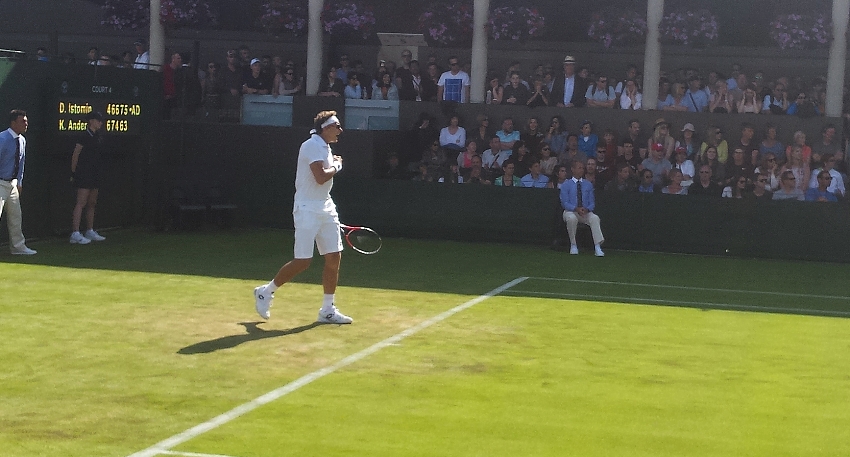
Your peers and coaches who know you seem to admire your work ethic. Is that important to you or does it make you proud?
[smiles] Well, I mean.. I just do my job. I try to do it the best I can. It’s my life, that’s my charisma and character I would say. I try to do my best and work in the best way I can. After my car accident, I had some trouble with my body, you know, a lot of problems with my body. A lot of injuries. Every season, I had something. I try to not think about it and just work.
You have been playing Majors for a long time and have done your best at Wimbledon and US Open, reaching 4th round in both. You have had a tough season so far too. Are you perhaps looking at this Wimbledon and think that it may be a good opportunity for you to recover and find your best game again?
I have a terrible season this year…
[I interrupt briefly, smiling] I did not want to use the word “terrible” in the question…
[Laughs] No, no, it was terrible, terrible… Let’s be honest, it’s been a terrible season. I lost a lot of matches. I had crazy injuries and illnesses, losses came one after another. But ok… It happened. You are human and these things happen. You just have to work around it and it’s going to be better. I just try to keep playing, you know? This kind of match can change a season as well, so I am looking forward to playing better and better.
Does Wimbledon hold a special place for you compared to the other three Majors?
The grass, in general, is my favorite surface. And of course, Wimbledon has a nice atmosphere and I really like it here. All Slams are strong you know, and you have to be at 100%. Finally, I am at 100%.. I hope [chuckles]. In Paris, against Juan Monaco, I strained my ankle after five games [Monaco won in four sets], but in the end I finished a five-set match today so it looks good.
What is one question that you wished you never heard again in your interviews and press conferences?
[smiles] I am not really like this, questions don’t really bother me too much. If someone wants to know what happened somewhere or if I slept well, I mean, that is a question too. They [media] are doing their jobs as well so, for me, it’s ok. If you ask me hundred times, like everybody did to me before, “how’s working with your mom?” every time I like to answer and say “I’m doing really great.”
Thank you for taking the time.
Thank you, I appreciate it.
(Edit: Click here to read my next chat with Istomin three days later, after 2nd-round win.)
Click here to follow MT-Desk on Twitter for frequent, live updates from the grounds.
As soon as the draws were announced at the Australian Open, it did not take long for the logical quarterfinals projections to be announced by the media members and tennis experts. The process is simple: you take the two highest seeds in each quarter and assume that they will beat their opponents to eventually face each other in that section of the draw for a berth in the semifinals. Thus, on the men’s draw the line up would be the following: Novak Djokovic (1) vs. Milos Raonic (8), Stan Wawrinka (4) vs. Kei Nishikori (5), Rafael Nadal (3) vs. Tomas Berdych (7), and Roger Federer (2) vs. Andy Murray (6). While those are dream match-ups for the second week and the tournament organizers, past experience tells us that the chances of this logical outcome coming to fruition is close to zero percent. Here are my takes on each quarter section, assuming that injuries play no part in the outcome:
Top quarter: Djokovic vs. Raonic
The chances of Djokovic getting upset early are close to none. He is a consistent performer in the Majors and it usually takes a monumental effort (Rafa at the French or Wawrinka 12 months ago in Melbourne are good examples) to eliminate Djokovic in a five-set battle. He rarely gets upset by lesser opponents. While I would be interested to see the talented Swede Elias Ymer do well, get past his first two rounds (tall order as it is, and not very likely), and take the stage against the number one player in the world, Djokovic is likely to get to the round of 16s without any complication. Then, he will have a more serious test, possibly against John Isner who has given him trouble in the past in two-out-of-three-sets matches. IIsner’s section, there are also couple of intriguing names, Dominic Thiem and Laurent Lokoli, who are looking for their first breakout Major tournaments. Throw in the dangerous Roberto Bautista-Agut and the in-form Gilles Muller, you have a fantastic early-round section with players battling to face Djokovic. Nevertheless, Djokovic should get to the quarters, possibly without even losing a set. Raonic’s path to the quarterfinals is a bit more complicated, but not until the third round. Once past his first two matches, he should face someone who will challenge him, such as Lleyton Hewitt or Julien Benneteau, who have wnough experience to trouble Raonic. If he gets past that, he will have to face either Feliciano Lopez who performs well in Majors and has the experience, or Gaël Monfils whom everyone fears except Nadal and Djokovic. Chances of Djokovic and Raonic meeting in the quarters: around 70%.
2nd quarter: Stan Wawrinka vs. Kei Nishikori
The big question here is “which Wawrinka will show up?” If it is the one from last year’s Australian Open or Wimbledon, look for him to steamroll his way to the quarterfinals. One player floating dangerously that nobody has heard of: Marius Copil. If he faces Wawrinka in the second round, it should be entertaining, providing that Copil does not melt under the “my-first-Major-appearance” syndrome. I do not see how Fognini, Dolgopolov, or anyone else in the third round, including Guillermo Garcia-Lopez who beat him in Paris, can stop Wawrinka. At first glance, Nishikori’s draw looks tough, but it could turn out to be a cakewalk. Nicolas Almagro would be one of the last players any seeded player cares to play in the first round, except that Almagro has not played an ATP match since Wimbledon due to a foot injury. I personally like Santiago Giraldo and Steve Johnson but I believe they are good match-up for Nishikori who can do everything they do, but a bit better. In the round of 16s, he will face the usually dangerous David Ferrer or Gilles Simon. I use the word “usually” seriously because in 2014, Ferrer was not the Ferrer that we are used to seeing for the last eight years, and Gilles Simon has battled injuries lately. I am looking for Nishikori to make it to the quarters easier than expected. Chances of Wawrinka and Nishikori meeting in the quarters: around 85%.
3rd quarter: Nadal vs. Berdych
Considering that he is not coming into the tournament on a high note, Nadal could not have asked for a better draw. Unlike Federer and Wawrinka, Nadal (like Djokovic) has the ability start a tournament on third gear, and eventually pull it to the fifth gear by the time the second week comes around. And all the names that could have given the Spaniard trouble in the early rounds are dispersed elsewhere. Don’t be fooled by some crazy upset pickers, his first round opponent Mikhail Youzhny is a shadow of his former self. The one name that stands out in his potential early-round opponents is Lukas Rosol. But this is not grass; it’s rather a slow version of hard courts. Does either Richard Gasquet or Kevin Anderson have a chance against Nadal if they play in the round of 16s? Anderson, small chance… Gasquet, none! In contrast to Nadal, Berdych has one of the hardest roads to travel in orderto reach the quarterfinals. Jurgen Melzer, his possible second-round opponent, has too much game and experience to be intimidated by neither Berdych nor a Major tournament atmosphere. Then, he will face Leonardo Mayer, Jiri Vesely, or Viktor Troicki, who are all able to cause an upset, and hungry for victories in the big stage. Even if he makes it through the first three rounds, Berdych will then have to take on a solid player such as Philipp Kohlschreiber (the last guy to get intimidated when playing a seeded player), Sam Groth (dangerous serve-and-volleyer who keeps improving steadily), or Ernest Gulbis (maybe the biggest loose cannon in the draw who can beat anybody depending on which side of the bed he wakes up that morning). Chances of Nadal and Berdych meeting in the quarters: around 60%.
4th quarter: Federer vs. Murray
Federer’s potential early-round opponents are composed of some solid names on the tour, but none good enough to cause a remarkable upset in a Major. Jeremy Chardy, Simone Bolelli, Borna Coric, Juan Monaco, Andres Seppi, Denis Istomin, can all beat a higher seeded player in any other ATP tournament (and have), or even take a set of a top player in a Major, but do not stand a chance to topple a top four seed here. Ivo Karlovic could be a dangerous fourth round opponent, but Federer seems to know how to deal with big servers, and Tommy Robredo (another potential fourth round opponent) defeating Federer in a Major will only happen once (2013 US Open). I can see Federer playing a few tiebreakers, or even losing a set (or sets) but do not see him losing prior to the quarterfinals. Andy Murray’s side has a couple of loose cannons in Marinko Matosevis and Martin Klizan who can be nightmares on the court. And yet, this is precisely what Murray needs, in order to be ready to face either Grigor Dimitrov, or David Goffin, or Dustin Brown (speaking of loose cannons), or Marcos Baghdatis, or Teymuraz Gabashvili in the fourth round. Yes, any of those can make it to the fourth round; this is by far the most contested section of the men’s draw. Again, Murray needs these tests to have a chance against Federer in the quarters, because he, like Djokovic and Nadal, can play himself into form as the tournament progresses. Chances of Federer and Murray meeting each other in the quarters: around 75%.
And now, it’s time to enjoy the first Major of 2015!
Follow MT-Desk on Tweeter throughout the tournament: @MertovsTDesk